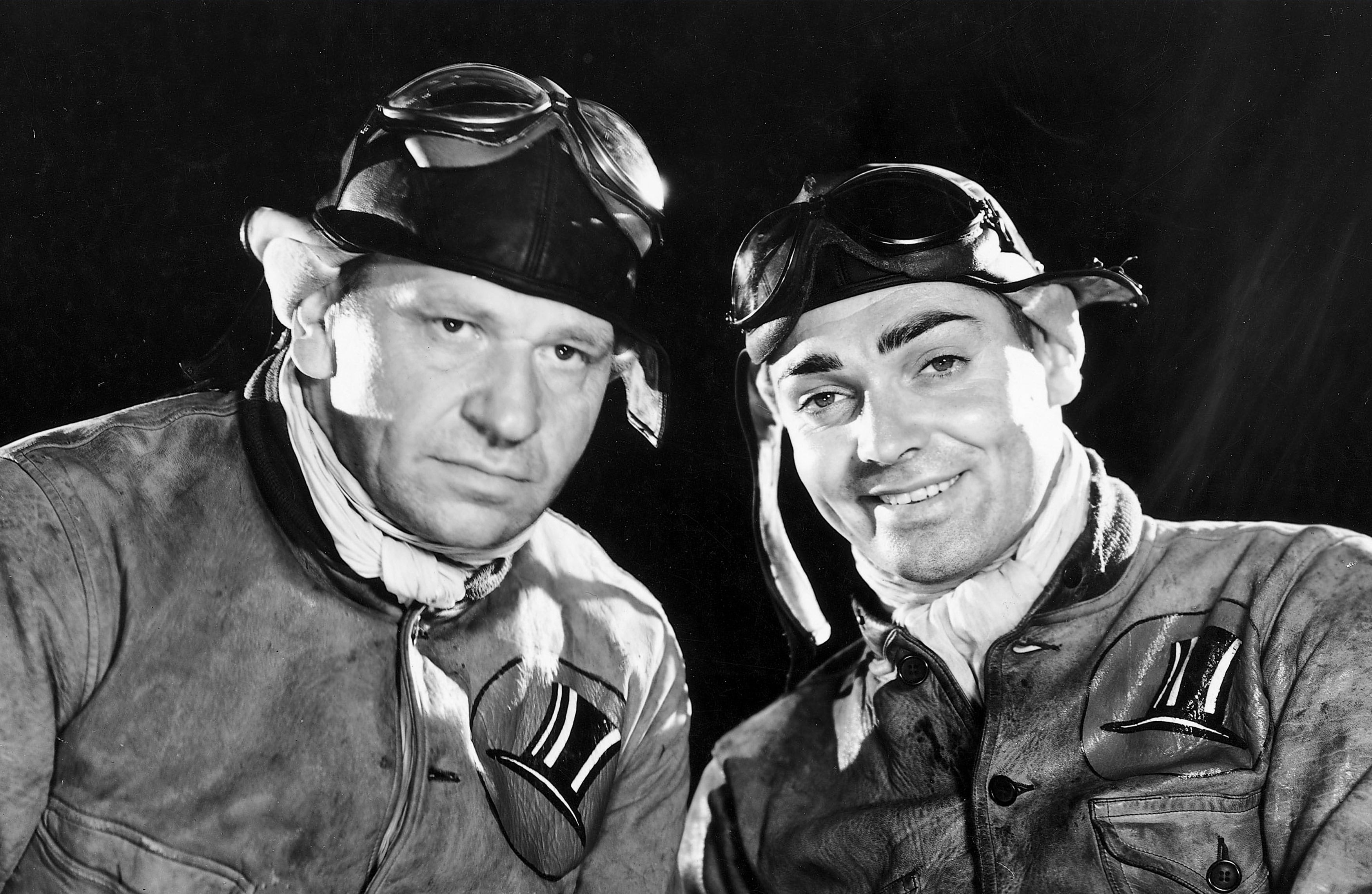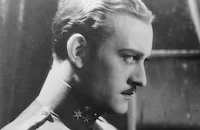Hell Divers

Brief Synopsis
Cast & Crew
George Hill
Wallace Beery
Clark Gable
Conrad Nagel
Dorothy Jordan
Marjorie Rambeau
Film Details
Technical Specs

Synopsis
"Windy" Riker, chief petty officer of the aviation squadron on the U.S.S. Saratoga , loses his five-year claim to the title of "champion dog fighter" when a young upstart C.P.O. named Steve Nelson joins the squadron. Soon after meeting, Windy and Steve engage in friendly competition as they try out a new vertical dive-bombing technique. Later, Windy, a notorious bully and troublemaker, is arrested for wrecking a Turkish bathhouse. Windy is spared punishment, however, when Jack Griffin, the commander of the unit, intervenes on his behalf. The friendly rivalry between Windy and Steve turns bitter when Steve questions Windy's explanation of a flying mishap and Windy punches him. When Ann Mitchell, Steve's sweetheart, visits her beau to discuss his marriage proposal, Windy, angry with Steve for not having been introduced to Ann, takes revenge on him by sending his friend Lulu to start an argument between them. Lulu pretends that she is Steve's ex-lover, which infuriates Ann and causes her hasty departure. Following a mid-air collision which cripples Jack, the squadron commander is retired, and Duke Johnson is appointed to take his place. When Windy makes an aviation error, he is confined to the ship while it docks in Panama. This prevents him from visiting his sweetheart Mame Kelsey, but allows Steve, who knows Mame, to meet her on the dock and share a carriage ride with her. Enraged, Windy sneaks off the ship and follows them. When he finally catches up to them, Mame prevents them from fighting and forces the two to make amends. As soon as they are left alone, however, Windy and Steve engage in a fight, which results in the destruction of a bar and Windy's arrest. Though Windy is sprung from jail in time to make his ship's departure, he soon learns that Steve will be replacing him as leading chief when his upcoming retirement takes effect. Windy is crushed by the news. During a mock battle drill, Steve's plane crashes, leaving Steve and his pilot stranded on a rocky island. When Windy and Duke discover the downed plane, they rescue the two at a risk to their own safety, and Windy sets Steve's broken leg. Steve and Windy resume their friendship as they wait for four days for a search party to find them. With no sign of a rescue mission to save them, Steve devises a plan to leave the island by having Windy fly the plane according to his navigation. In order to lessen the danger of flying too heavy, the injured Steve insists on riding the wing. Together, the servicemen locate the aircraft carrier, but when the plane crashes onto the vessel's deck it explodes, killing Windy. Following Windy's burial at sea, Steve reads a letter that Windy wrote to him before his death. In the letter, Windy reveals that Ann left him not because she did not love him, but because of his deeds.

Director

George Hill
Cast

Wallace Beery

Clark Gable

Conrad Nagel

Dorothy Jordan

Marjorie Rambeau
Marie Prevost

Cliff Edwards

John Miljan
Landers Stevens
Reed Howes
Alan Roscoe

Frank Conroy

Robert Young
Niles Welch
Crew
Robert Barnes
Malcolm Stuart Boylan
Harvey Gates
Cedric Gibbons
Ralph Graves
George Hill
Robert Hoag
Reginald Lanning
Harold Lipstein
Bert Lynch
Charles Macarthur
E. J. Mannix
Charles A. Marshall
Harold Marzorati
James K. Mcguinness
Kyme Meade
Charles O'malley
Albert Scheving
Blanche Sewell
Douglas Shearer
Robert Shirley
Charles Straumer
Edward Dean Sullivan
Frank Wead
Harold Wenstrom

Film Details
Technical Specs

Articles
Hell Divers (1931)
The action is plentiful throughout, and the aerial sequences are especially thrilling, even today. The picture was made with the cooperation of the U.S. Navy and was shot on the aircraft carrier Saratoga and on North Island, Panama. Critics dismissed it ("There is no story," said The Hollywood Reporter), but the film was very successful commercially. And it did have a story, credited to Frank "Spig" Wead. Wead was a WWI flying ace-turned-writer whose interesting life story would later be told by director John Ford in The Wings of Eagles (1957), a movie that even incorporates a clip of Hell Divers.
This was Gable's eighth film for MGM in 1931 alone. He had started as a bit player earlier that year and by Hell Divers, he was a star. Beery was still the bigger star at this point, however, especially since he had just finished work on The Champ (1931), for which he would win the Best Actor Oscar®. Gable did not care much for Beery or this film, but he did research the role by hanging out with Navy men. One little quirk he learned was that the Navy fliers never took a lemon twist with their gin but rather had a slice of lemon on the side, biting the lemon between gulps. Gable picked up the habit himself for years after this film.
Director George Hill was a very imaginative filmmaker whose silent-era experience as a cameraman led to visually atmospheric talkies as a director, such as The Big House (1930) and The Secret Six (1931). He was married to screenwriter Frances Marion for three years and collaborated with her many times. We'll never know what gems his talent might have produced, for after Hell Divers he completed only one more picture, Clear All Wires (1933), before committing suicide at his beach house. (He had begun pre-production on The Good Earth; director Sidney Franklin took over and the film, starring Paul Muni, became a classic.)
Supporting actress Marie Prevost died gruesomely only six years after this film. A silent screen star who had appeared in three sparkling Ernst Lubitsch comedies (including 1924's The Marriage Circle), she had trouble transitioning to talkies due to her strong accent (she was raised in Canada), developed weight problems, and fell into bit parts in the 1930s while turning to the bottle. Broke, she died of alcoholism and malnutrition in her run-down Hollywood apartment, and her body wasn't discovered for two days, during which time, according to Kenneth Anger in Hollywood Babylon, her starving dog had nibbled on her corpse.
Prevost's co-stars would have happier futures. Dorothy Jordan, who appears here as Gable's love interest, retired in 1933 to marry producer Merian C. Cooper, and made a brief comeback in the 1950s to play small roles in three John Ford films - including the wife still in love with John Wayne in The Searchers (1956). Cliff Edwards, who plays the character "Baldy," would go on to supply the voice of Jiminy Cricket in Pinocchio (1940) and sing the Oscar®-winning "When You Wish Upon a Star." Also in the cast is future star Robert Young in a bit role as a sailor.
Producer: George W. Hill
Director: George W. Hill
Screenplay: Frank Wead (story), Harvey Gates, Malcolm Stuart Boylan, James Kevin McGuinness, Ralph Graves
Cinematography: Harold Wenstrom
Film Editing: Blanche Sewell
Art Direction: Cedric Gibbons
Music: Sarah Adams, General Daniel Butterfield, Lowell Mason, J.L. Molloy, Charles A. Zimmerman
Cast: Wallace Beery (CPO H.W. Riker), Clark Gable (CPO Steve Nelson), Conrad Nagel (D.W. Johnson), Dorothy Jordan (Ann Mitchell), Marjorie Rambeau (Mame Kelsey), Marie Prevost (Mrs. Lulu Farnsworth).
BW-110m. Closed captioning.
by Jeremy Arnold

Hell Divers (1931)
Quotes
Trivia
This was the first film in which Wallace Beery sang and played the piano.
Notes
Writer Frank Wead is credited onscreen as "Lieutenant Commander Frank Wead." According to a contemporary Hollywood Reporter news item, Hell Divers had a sneak preview showing in San Bernardino, California, on October 29, 1931. M-G-M publicity material notes that this picture, which was filmed with the cooperation of the U. S. Navy Department, featured Clark Gable in his first starring role, and this it was the first film to feature "fighting-diving bombers." Studio publicity records also indicate that Wallace Beery played the piano and sang for this film, the first time he had done so in any picture. Hollywood Reporter pre-release news items indicate that Edward Dean Sullivan and Charles McArthur worked on the adaptation, and that actors Eric Alden and Eric Holden were set for parts. The appearance of Holden and Alden in the released film has not been confirmed.
According to a 1956 New York Times news item, some footage of this film was incorporated into the 1957 M-G-M picture The Wings of the Eagles, a film based on Frank Wead's life. Portions of Hell Divers were filmed aboard the U.S aircraft carrier Saratoga while on maneuvers in Panama, in the Caribbean Sea, and on the North Island Naval Base near San Diego, California.















